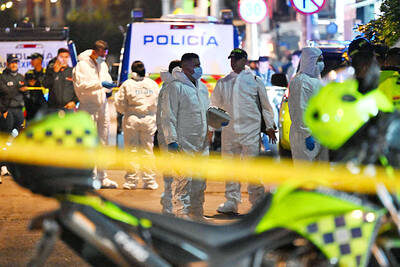Long the traditional source of opium used for making heroin, the so-called Golden Triangle could become a minor source of the poppy in the next few years.
Afghanistan has taken its place.
A UN report on illegal drugs, made public on Wednesday, provides both good news and bad news. Declining use or production in some areas is countered by new markets elsewhere or new centers of production or trafficking, including North Korea.
The report, released in Paris by the UN Office on Drugs and Crime, showed that nearly 200 million people around the world used illegal drugs in 2000-2001.
"Globally, cocaine is the problem of the Americas, heroin is the problem of Asia and cannabis is the problem of Africa," the agency's executive director, Antonio Maria Costa, said.
Cannabis "continues to be the most widely produced, trafficked and consumed illicit drug worldwide," with nearly 163 million people using it, according to the UN report.
Cocaine use remains a problem but production decreased for the second straight year.
Heroin production increased despite a "major reduction in poppy cultivation" in the Golden Triangle area in southeast Asia, where Myanmar, Thailand and Laos meet.
A 16 percent increase in poppy cultivation between 1998-2002 in southwest Asia comes mainly from Afghanistan, which produces 76 percent of the world's opium.
"The price of a gram of heroin in Afghanistan is between is between US$1 and US$5, while it sells for nearly US$100 in Europe," Costa said.
Costa said earlier this month that war and lawlessness have fed the surge in poppy production in Afghanistan, helping the drug economy to thrive.
Marijuana production also appears to be increasing. However, in the US, use fell in 2002 among high school students, almost 10 percent less than in 1997 and some 30 percent less than in the late 1970s, the report said.
The number of people around the world who abuse opium and heroin has also remained stable at about 15 million. Opium, derived from the poppy plant, is a narcotic that can be smoked on its own and serves as the main ingredient in heroin.
But decreases in Western Europe have been countered by growing markets in East Europe, Russia and Central Asia.
Also increasing is intravenous heroin abuse, which, through addicts sharing used needles, is causing AIDS to expand at an alarming rate, the report says.
A drop in demand in Australia, where trafficking networks were being dismantled, was apparently being compensated by heroin "originating in, or being trafficked" via North Korea, according to the report.
Cocaine is abused by about 14 million people, with the US the world's largest cocaine market. Two of the three main suppliers, Bolivia and Peru, are both successfully reducing coca production.
The number of cocaine users in the US has stabilized, with some 15 percent less using in 2002 than in 1998, and 60 percent less than in 1985, according to the report.
Production of synthetic drugs, often made with easily available chemicals in concealed laboratories, is hard to track.
Amphetamine-type stimulants like Ecstasy, known as ATS, represent an expanding market, particularly in the US, the report said, based on the number of seizures of labs and end-products and consumption reports.
However, the market is changing, and trafficking is shifting toward east Asia and southeast Asia. North Korea is "emerging as a significant source-transshipment area for methamphetamine going to Japan," the most lucrative market in the region.
In Europe, the Netherlands and Belgium remain the center of ecstasy production, together with Poland, the report said.

A Chinese scientist was arrested while arriving in the US at Detroit airport, the second case in days involving the alleged smuggling of biological material, authorities said on Monday. The scientist is accused of shipping biological material months ago to staff at a laboratory at the University of Michigan. The FBI, in a court filing, described it as material related to certain worms and requires a government permit. “The guidelines for importing biological materials into the US for research purposes are stringent, but clear, and actions like this undermine the legitimate work of other visiting scholars,” said John Nowak, who leads field

Swedish campaigner Greta Thunberg was deported from Israel yesterday, the Israeli Ministry of Foreign Affairs said, the day after the Israeli navy prevented her and a group of fellow pro-Palestinian activists from sailing to Gaza. Thunberg, 22, was put on a flight to France, the ministry said, adding that she would travel on to Sweden from there. Three other people who had been aboard the charity vessel also agreed to immediate repatriation. Eight other crew members are contesting their deportation order, Israeli rights group Adalah, which advised them, said in a statement. They are being held at a detention center ahead of a

‘THE RED LINE’: Colombian President Gustavo Petro promised a thorough probe into the attack on the senator, who had announced his presidential bid in March Colombian Senator Miguel Uribe Turbay, a possible candidate in the country’s presidential election next year, was shot and wounded at a campaign rally in Bogota on Saturday, authorities said. His conservative Democratic Center party released a statement calling it “an unacceptable act of violence.” The attack took place in a park in the Fontibon neighborhood when armed assailants shot him from behind, said the right-wing Democratic Center, which was the party of former Colombian president Alvaro Uribe. The men are not related. Images circulating on social media showed Uribe Turbay, 39, covered in blood being held by several people. The Santa Fe Foundation

NUCLEAR WARNING: Elites are carelessly fomenting fear and tensions between nuclear powers, perhaps because they have access to shelters, Tulsi Gabbard said After a trip to Hiroshima, US Director of National Intelligence Tulsi Gabbard on Tuesday warned that “warmongers” were pushing the world to the brink of nuclear war. Gabbard did not specify her concerns. Gabbard posted on social media a video of grisly footage from the world’s first nuclear attack and of her staring reflectively at the Hiroshima Peace Memorial. On Aug. 6, 1945, the US obliterated Hiroshima, killing 140,000 people in the explosion and by the end of the year from the uranium bomb’s effects. Three days later, a US plane dropped a plutonium bomb on Nagasaki, leaving abut 74,000 people dead by the